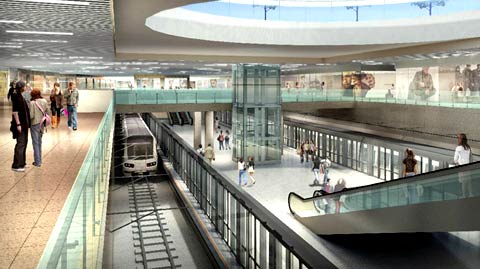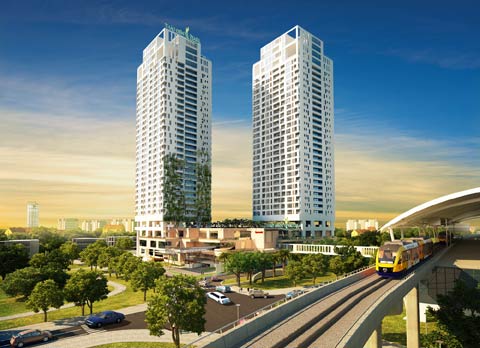August 28th, the construction of Ho Chi Minh City’s first metro line No.1, 20 kilometer in length, has broken ground after several postponements. The Ho Chi Minh City Metro System – a foundation for an anticipated modern development – will soon be realized.
The dream for a metro network running throughout Ho Chi Minh City has been kindled since the late 1990s. From 2001 to 2007 there have been many debates and disagreements on the location of the tracks, and how to build them. By February 2008, the construction of a 24-hectare wide depot in Long Binh Ward, District 9 of metro line Ben Thanh - Suoi Tien has begun; however, due to ground clearance issues the project has been late since then. After four years of delay, on 28/8, the most important part of this metro line was officially broken ground.
According to the design, metro line No. 1 will span a nearly 20-km long route through District 1, 2, 9, Binh Thanh, Thu Duc (HCMC) and Di An District (Binh Duong province). About 2,6 km of the metro line No.1 will be underground (3 stations) and more than 17 km long elevated section (11 stations).
 |
| Perspective of metro - source by Management Authority For Urban Railway |
In particular, the underground section will consist of 3 stations, with a 2.6-km long starting from station No. 1 (Quach Thi Trang Roundabout area, in front of Ben Thanh Market) going pass the Saigon Opera House and the office of the Saigon Electricity Company, following Nguyen Sieu street, passing Fafilm heading to Ba Son plant.
From station No. 3 (Ba Son Station) onward, the metro line will be elevated with 11 stations. This section will start from the northern region of Ba Son, beyond Nguyen Huu Canh Street, going across Van Thanh and Tan Cang zones and then will run along Hanoi Highway to Suoi Tien (station No. 14). Finally, the line will turn right into Long Binh Depot to conclude the journey.
The outstanding advantage of the metro system is its massive passenger capacity, reaching up to hundreds thousands passengers per trip. HCM City is putting much hope in this metro project to reduce significantly the issue of traffic jam due to the excessive number of personal vehicles currently in use, primarily in the eastern region of the city where tens of thousands of students travel and study every day.
According to the design, the passenger flow for metro line No. 1 is about 162,000 passengers per day (during the period of 2014-2020), to be raised to approximately 635,000 (2030) and 800,000 (2040). Travel time on the entire length of the line is about 30 minutes, equivalent to a velocity of 40 km/h. According to expectation, the train will operate 20 hours a day with 5-6 minute downtime between trips.
Additionally, the underground areas comprise of metro stations and future commercial complexes also promise to create a new look for the downtown area. According to the agreement between the People's Committee of Ho Chi Minh City and JICA (Japan International Cooperation Agency), the research team has conducted a preliminary study for two zones: the Square in front of Ben Thanh Market (dedicated parameter for central station), and the area along Le Loi Street (proposed location for an underground commercial center).
 |
| Perspective of the underground commercial center & center station of Metro Line No.1 |
Accordingly, the area of Ben Thanh central station will be constructed 40 m underground, consisting of a three-storey station area servicing 4 metro lines (first floor: Metro line No. 1 and 3A, second floor: line No. 2, third floor : line No. 4); and a commercial area surrounding the stations. For Le Loi Street area (connecting the central station and the Opera House station), the research team proposed to build a commercial center surrounding the underground station of of metro line No. 1, with an area of about 25,500 m2. As such, the gross underground area including Ben Thanh central station and underground commercial areas along Le Loi Street is about 45,000 m2.
Mr. Le Khac Huynh, deputy chief of Management Authority for Urban Railways (MAUR) at Ben Thanh zone said that in addition to maximizing the utilization of underground space, the idea of building commercial complexes accompanying the metro stations will bring convenience and services to metro passengers. Additionally, the profit from these commercial centers will contribute in offsetting the investment cost of the metro project. This is a model that many countries around the world, including Japan, have deployed successfully. There is also an issue of high importance regarding how to connect metro’s public passengers to their final destination most conveniently. MAUR is researching feasible associations with existing public transport systems (bus, taxi, etc.). This program will connect to the overall city public transportation.
Expressing enthusiasm for this project, Mr. Huynh Dung, who lives in Vo Van Ngan Street (Thu Duc District), said that he look forward to the day the Metro system gets rolling. "The Construction of the metro is the general trend of developed cities; it is very good news that we can now build our first metro line. I'm already very excited just thinking about having to only walk into the metro to get straight to my office in the morning, and once again heading home in the evening, without having to suffer traffic jams".
 |
| Station 6 directly will connect to the third floor of Thao dien Project |
From the perspective of a real estate investor, Mr Nguyen Van Doi – Director of the Thao Dien Pearl project - one of the project with entrance directly connected to a metro station, expressed much expectation regarding a model of residential and commercial complex to be developed like the in other countries in the region such as Japan, Singapore and Malaysia. According to Mr Nguyen Van Doi, the great advantage derived from convenient transportation and rapid connection will help residents and business partners at Thao Dien Pearl increase their home value, investment value, and leasing value within a short period of time.
Many other experts also expressed that the construction of the first metro line eastward of the city (Ben Thanh - Suoi Tien) is an appropriate policy. "This area is relatively developed; there are many high-rise buildings, entertainment centers, high-tech compounds and national universities. Therefore, by building the metro here, we will ensure a higher number of passengers than in other urban areas. And thus, there will be a sufficient source of revenue to support the system once it is in operation,” an expert in the field of transport commented.
|
Metro is an urban mass transit system which has a transport capacity larger than the ground railway (Tramway) or one-track railway (Monorail). Metro is a type of trains (similar to our railway trains in operation at the moment) but running on electrical power (not using Diesel rolling stock like railway trains). Depending on the number of passengers at peak hours, the train has 3 to 6 cars and runs at a time interval of 3 to 10 minutes. In addition to metro line 1, Ho Chi Minh City plans to build more 6 metro lines include: Line No. 2 (Thu Thiem –Tay Ninh bus station) is about 20 km long. Line No. 4 (Nguyen Van Linh - Ben Cat Bridge) is 24 km long. Line No. 5 (Sai Gon Bridge – Can Giuoc bus station) is about 17 km long. Line No. 6 (Ba Queo - Phu Lam rotation) long 6 km. Except metro line No.3 is about 23 km long was split into two: Line No. 3A (Ben Thanh Tan Kien). Line No.3B (Cong hoa- Hiep Binh Phuoc).
|
Source: vnexpress.net












 Back
Back Go top
Go top Print
Print Send to your friend
Send to your friend